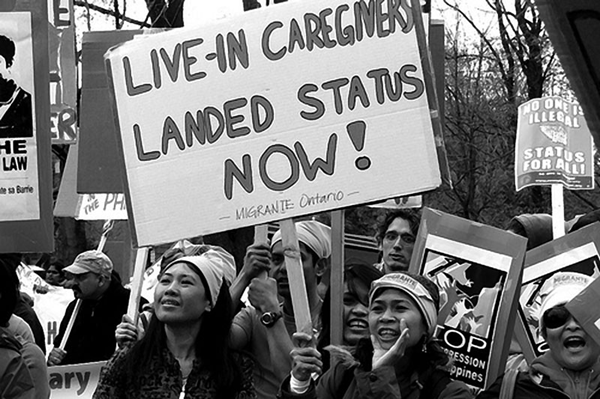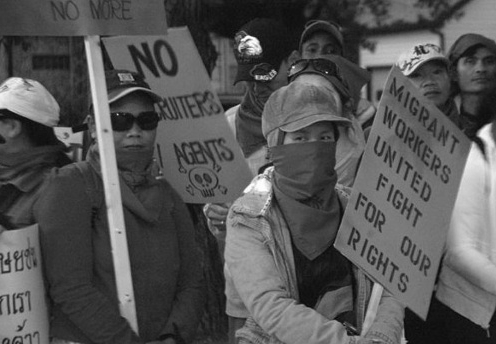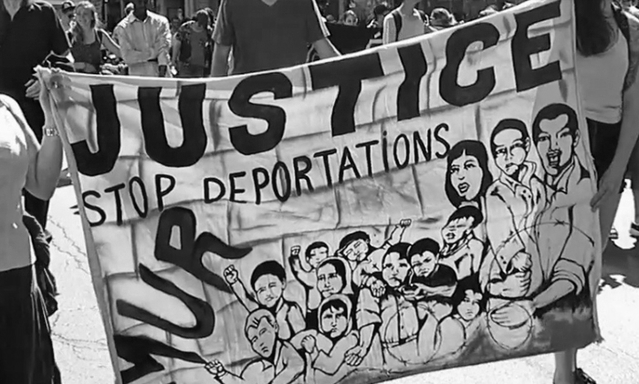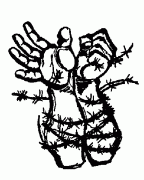The following text is taken from an article published by Solidarity Across Borders in the Spring of 2015. The full article can be found online here.
As author David McNally has observed, “It’s not that global business does not want immigrant labor [in] the West. It simply wants this labour on its own terms: frightened, oppressed, vulnerable.” In lockstep with the consolidation of neoliberal austerity, economies throughout the Global North have come to rely increasingly on immigrants and migrants. The goal is to have access to hyperflexible low-cost labour: use-up-and-dispose workers, people to be exploited and then sent home, without any possibility of accessing the oppressor- nation privileges their labour has helped maintain. Coming from societies in the Global South which have been devastated by (neo-)colonialism, for many of these people austerity is not something new, just more of the same. The services and resources being cut back were often designed to never be accessible to them in the first place.
It is no coincidence that the first temporary work program was created in 1966, just a few years after the explicit racial categories that had previously defined immigration law in Canada were removed. The Non- Immigrant Employment Authorization Program (NIEAP) created a distinct category of “low-skilled” workers, the majority of whom would come from the Global South. It took some years for NIEAP to fully come into its own, but by the 1980s, temporary employment authorizations had eclipsed the number of workers permitted entry on a permanent basis.

In parallel with this, the class trajectory of even permanent immigrants to Canada began to change. A majority of immigrants, even those who were middle class in their country of origin, were now funneled (by mostly informal racist mechanisms) into the most exploited and precarious jobs. As such, structural racialization of low-wage work persisted even amongst “new Canadians”. (At the same time, a privileged section of these immigrant communities has been integrated into the multicultural middle class and worker elite. This immigrant middle class is squeezed between its own contradictions with settler-colonialism (dealing with racism in addition to the same neoliberal pressures as the rest of the middle class) and the role it plays politically binding the precarious immigrant working class to the neocolonial project – or at least neutralizing its opposition.)
The Temporary Foreign Worker Program (TFWP) was established in 2002 as an outgrowth of the NIEAP. It has rapidly expanded, tripling since 2006, further signaling the centrality of this hyperflexible workforce to capitalism’s plans. Employers are able to source labour from any country around the world without government oversight or bilateral agreements. There is no path to permanent residency; workers’ right to remain in Canada is tied to their employer. Most migrant workers return year after year to complete the same “short-term,” exploitative contract job.
These workers have been “permanently temporary” locked into a situation of persistent insecurity. However, changes that came into effect on April 1, 2015, will make their situation even worse. The new “4 and 4” legislation, targeting the most highly exploited workers in the TFWP, will limit these people to working four years and will then bar them from re-entering the country for the next four years. This is intended to make workers even more isolated and vulnerable, ushering in a system of revolving- door immigration for the most exploited. All low-waged temporary workers as well as migrants employed under the Live-In Caregiver streams who have worked in Canada for more than four years will be banned from working and forced to leave – one of the largest deportations in Canadian history. Eventually, over 60,000 people currently living in Canada (and hundreds of thousands more who will temporarily replace them) will be deported, forced to leave, or confined to surviving here as criminalized undocumented workers.

In addition to the 300,000 migrants working under the TFWP, there are currently an estimated 250,000-400,000 such undocumented immigrant workers in Canada. These people mainly work for cash, often without access to minimum wage, social assistance, or any basic labor protections. They constitute the most highly exploited section of the working class in this country.
While the Canadian State seeks to expand this hyperflexible migrant sector, it has simultaneously moved to restrict paths of permanent migration. As Harsha Walia of No One Is Illegal recounts, according to “Avvy Yao-Yao Go, Director of the Metro Toronto Chinese and Southeast Asian Legal Clinic, ‘Thirty years ago, family-class immigrants made up the majority of all immigrants. Today, they account for less than 20 per cent of the total intake.”
“The Conservative government has instituted a quota of 5,000 applications (note, not acceptances) on the sponsorship of parents and grandparents. This comes after a complete two-year moratorium on reunification with parents or grandparents.”
“In order to even qualify, the government has imposed stringent income requirements and families have to sign a 20-year financial undertaking. This means that for two decades sponsored parents and grandparents cannot access social assistance without returning it.”
Changes to family reunification are part and parcel of a series of government attacks against “undesirable” immigrants. Following the implementation of the Orwellian “Protecting Canada’s Immigration System Act” (Bill C-31) in 2012, refugee acceptance rates were the lowest in Immigration and Refugee Board history, at 33%. In 2013, there were more than 15,000 deportations – over 40 a day – and over 9,000 people were caged in immigration prisons between 2012 and 2013. The government’s announcement in December 2014 that it was lifting the ban on deportations to Zimbabwe and Canada’s neocolony Haiti – because the situation in those countries has “improved” – means an additional 3,500 will face potential removal. (This underscores the hypocrisy of the global apartheid system: these two countries, now judged safe to deport people to, each remain subject to government travel advisories warning that they are unsafe for Canadian tourists.)
Meanwhile, also in 2014, Bill C-24 became law, making it possible to revoke citizenship from dual nationals or even from Canadian- born children who have the possibility of accessing dual citizenship. In a shocking precedent, as a result of a minor non-violent criminal charge, Ottawa-born and Canadian passport-holder Deepan Budlakoti is facing expulsion to India, a country he only ever visited briefly when he was 12. It is a deportation frenzy.

The Reproduction of Labour
Capitalists seek to extract the maximum labour from each worker, at minimum cost; for capitalism a worker is their labour power, and nothing more. The “permanently temporary” migrant worker suffers extreme forms of exploitation as capitalism pursues this ideal. The “temporariness” is key here, as it translates into massively reducing security and access to services or benefits outside of work, regardless of how many years one has worked here.
Canadian employers are able to use such workers without bearing any of the costs of raising them, educating and training them, supporting them when they are sick and when they become elderly, or providing for their children or other dependents. The costs of reproducing this labour force are pushed out of the oppressor nations, relegated to workers’ communities and families in the Global South. Meanwhile, within Canada, non-status people are frequently denied access to healthcare, schooling, and other social services. Indeed, even non-State services, for instance many food banks, often refuse to provide assistance to people who are unable to provide the proper “legal” identification. Such exclusion is frequently experienced as a hardship not only by the people directly affected, but also by family members who do what they can to step into the vacuum. In the Global South as in the Global North, such work often falls on women, as grandmothers, mothers, wives, sisters, and daughters do what they can to step in and care for their family members in distress. That such feminized “reproductive labour”, both within Canada and offset onto the Global South, is either poorly paid or not paid at all, constitutes a source of superprofits that is as great as it is hidden.

Furthermore, migrant women in Canada suffer all of the same forms of exclusion as men, while also facing specific forms of gendered violence and oppression. In each regard, Canadian racism and sexism exacerbate the oppression and exclusion in question. For instance, as of August 2014, spouses must now arrive on a two-year conditional probationary visa before gaining permanent status, a fact which increases the vulnerability of immigrant women in abusive relationships as it makes their legal status contingent on staying with their partners. Further, under white supremacy, racialized and Indigenous women, queers, two-spirit, trans, as well as all those that fall beyond patriarchal gender and class norms, bear the brunt of capitalist and colonial violence. Within this, Canadian law enforcement itself remains a significant source of violence.
Finally, as shown in the case of the Quebec Charter of Values, women perceived as “foreign” are prime targets for racist violence and patronizing regulation. In the current period of heightened Islamophobia this is a particularly intense reality for Muslim women, who are simultaneously characterized as uniquely oppressed and uniquely dangerous. However, all women deemed “other” - not only immigrants and Muslims, but also (depending on circumstances) Indigenous women and two- spirited peoples, poor women, sex workers, transwomen, and others - are vulnerable to such hate campaigns, which serve to keep them in a position of insecurity, just as they serve to bind (other) oppressor-nation women more tightly to their “own” patriarchal structures.

** Since this article was published, the Canadian government re-instated the moratium on deportations to Haiti and Zimbabwe (in December 2015). While this effectively halted the deportation of Haitians and Zimbabweans, it has left them in limbo, still fighting for permanent status.
